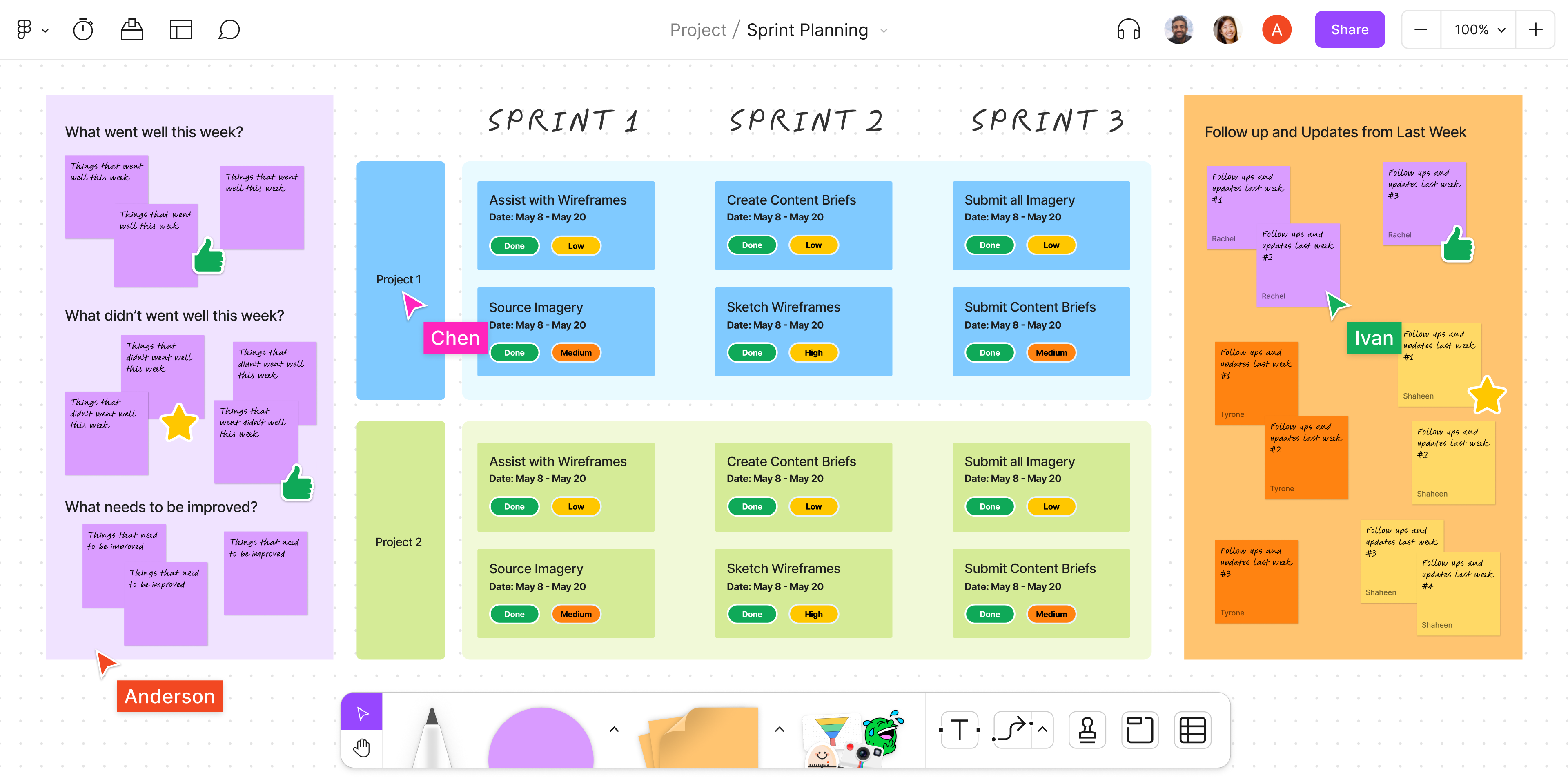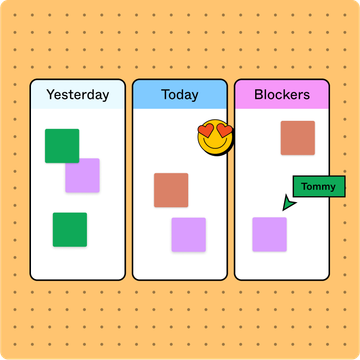What is sprint planning and how can it help your team?

Take a look at your team calendar: how many of those project deadlines make sense, and who actually set them? Sprint planning is your opportunity to get your team involved, so that you can set and achieve realistic goals in a tight timeframe, or sprint. Read on to find out how to plan sprints effectively with a step-by-step guide, pro tips, and tricks from FigJam.
What is a sprint, and how do teams plan sprints?
In agile management, a sprint is a limited timeframe within a larger project scope when scrum team members finish specific tasks to meet a project milestone. Like its namesake in track and field, a sprint involves working quickly and efficiently to complete a defined set of tasks over a short period—usually two weeks per sprint.
Sprint planning brings your team together to:
- define the sprint goal,
- determine the tasks necessary to meet that goal, and
- decide who will be responsible for each task from the project backlog to complete by the end of the sprint.

Sprint planning doesn't have to be hard
FigJam's free sprint planning template makes it easy hit the ground running. Get started today.
Who is responsible for sprint planning?
The entire scrum team collaborates to determine what work needs to be done in a sprint and who will do that work. Sprint leaders (also called scrum masters) review the longer-term project holistically, then guide the scrum team to outline a feasible sprint plan covering:
- What are the tasks necessary to achieve the sprint goal?
- What are the sprint deadlines?
- Who will be responsible for sprint tasks?
- How will the team accomplish their work?
Why is sprint planning important?
Sprint planning guides teams toward a goal and helps everyone stay focused throughout the sprint. But sprint plan benefits go beyond establishing a set of tasks to complete, setting the stage for better team collaboration.
This process puts everyone on the same page, with a collective understanding and shared expectations. When everyone on your team knows why the sprint is important and can determine how tasks will be completed, the team will be motivated to give their all. Collaboration builds motivation.
3 key considerations in sprint planning
- Value. Start your sprint planning session by asking, "Why is this sprint valuable?" Answering this question should surface a clearly defined sprint goal all team members can understand and own.
- Backlog. Look at the project's backlog of tasks, and select the tasks necessary to reach the sprint's goal. That group of tasks is your sprint backlog. Remember, this is a sprint, not a marathon. Select only tasks you can reasonably expect your team to complete by the end of the sprint.
- Process. Plot your sprint backlog onto a timeline and assign tasks to team members. Each task during the sprint should take at most a day to complete. If any task seems like it will take longer, break it into two or more tasks.
4 steps to successful sprint planning
Effective sprint planning helps your team see eye-to-eye on daily project work, and foresee the exciting possibilities ahead. Here's how the pros do it.
Step 1: Designate a scrum master.
The scrum master guides the entire sprint, including the planning process. They lead through service, ensuring that the planning process is truly collaborative and everyone has what they need to achieve sprint goals.
Step 2: Define your sprint backlog.
If you're developing a new product or launching a website, your overall project backlog might include UI or UX design, feature development, and debugging. If an action item isn't on the backlog, don't include it in your sprint plan. On the other hand, just because an item appears on a backlog, doesn't mean it will get done in your sprint. You have to be selective and prioritize.
Step 3: Create a task board.
Tasks to be accomplished during a sprint go onto your task board. Here you can sort your tasks into “To do,” “In progress,” and “Done.” A digital board will allow you to plan collaboratively, even if your team spans continents. FigJam's sprint planning template covers key details, including task descriptions, due dates, and team member assignments.
Step 4: Determine your definition of “done.”
Collaborate with your team to build a list of required criteria for completion of sprint tasks. Sometimes this is referred to as DONE-done or READY-ready, as in, “You say you're done, but are you DONE-done?” Setting the finish line before starting your sprint helps keep everyone on course for successful completion.
5 pro tips for sprint planning with FigJam
Figma's sprint planning template provides all the built-in tools your team needs to whip through your sprint backlog. This handy sprint planning template makes it easy to plan multiple projects at a time, map out sprints in advance, and update sprint plans as needed.
Here's how to start sprint planning with FigJam:
- Invite your team to collaborate with you via the sprint planning template.
- Determine your sprint goal with a real-time conversation in Figma's collaborative online whiteboard. Remember to make goals clear so that even stakeholders who aren't on the team can understand why you're working towards this goal.
- Review your overall project backlog with your team, and select the tasks the team will need to accomplish to meet the sprint goal.
- Prioritize tasks as “high,” “medium,” and “low” using Figjam's Kanban template, which has a built-in voting tool.
- Set deadlines for the tasks and assign them to team members. Don't forget to update your tasks to “in progress” and “done” while you work, so that you can celebrate daily wins along the way.
Congratulations: with these pro tips and FigJam planning tools, you're ready to run your sprint!
Sources
[1] https://www.apm.org.uk/resources/find-a-resource/agile-project-management/
[2] https://www.businessnewsdaily.com/4987-what-is-agile-scrum-methodology.html
[3] https://www.agilealliance.org/glossary/backlog/
[4] https://scrumguides.org/scrum-guide.html#sprint-planning
[5] https://blog.codegiant.io/20-deadline-management-tips-scrum-masters-should-consider-e8842d177575
[6] https://kissflow.com/project/agile/scrum-sprint-planning/
[8] https://www.agilealliance.org/glossary/backlog/
[9] https://www.scrum.org/resources/what-is-sprint-planning
[10] https://www.knowledgehut.com/blog/agile/how-to-choose-a-scrum-master
[11] https://monday.com/blog/project-management/product-backlog/
Keep reading

Running a sprint retrospective
A well-run sprint retrospective tweaks workflows and strengthens teamwork, helping everyone deliver portfolio-worthy design on time.
Mehr erfahren

How to create a product development roadmap
Get your next product effort off to a running start with a product development plan that clearly maps out your goals, priorities, and timelines.
Mehr erfahren

How to run great daily standups
How do you make sure everyone's on board, on task, and on track for a productive day ahead?
Mehr erfahren




